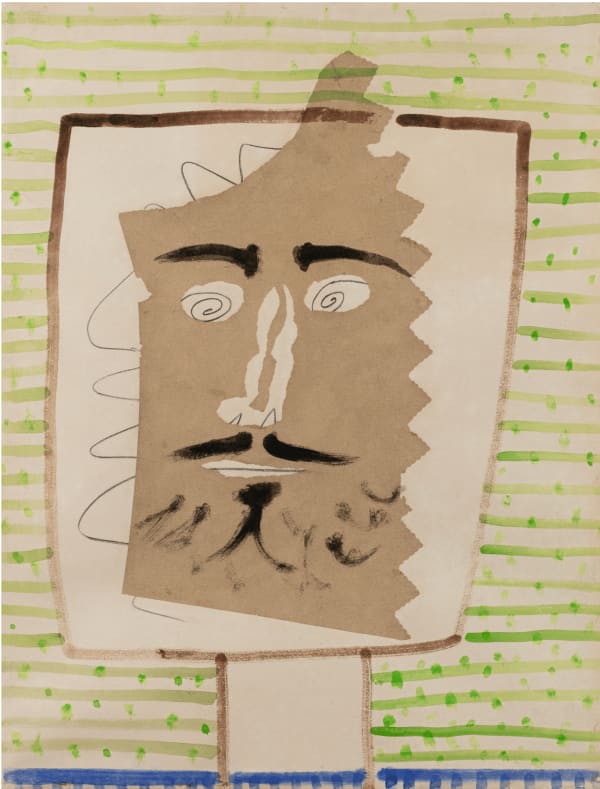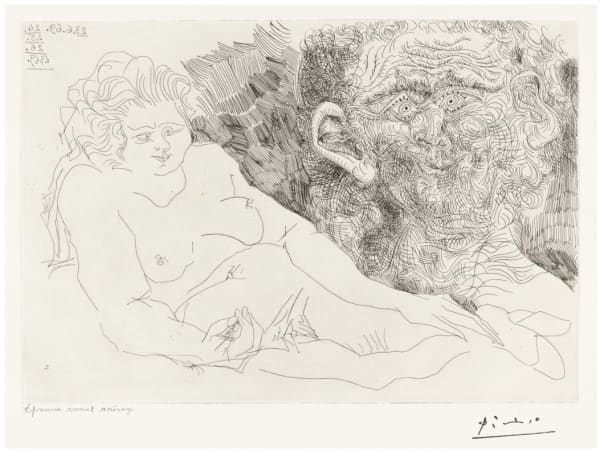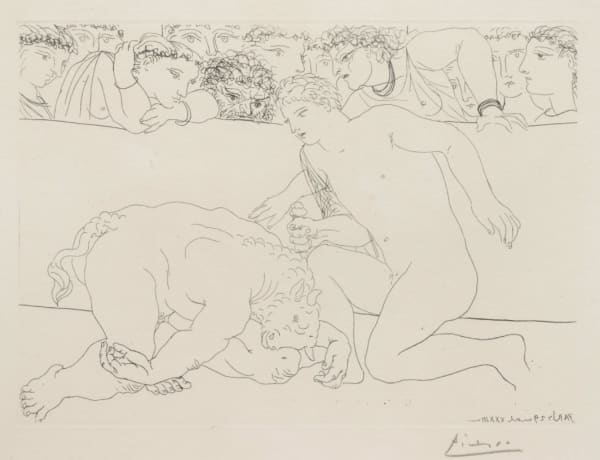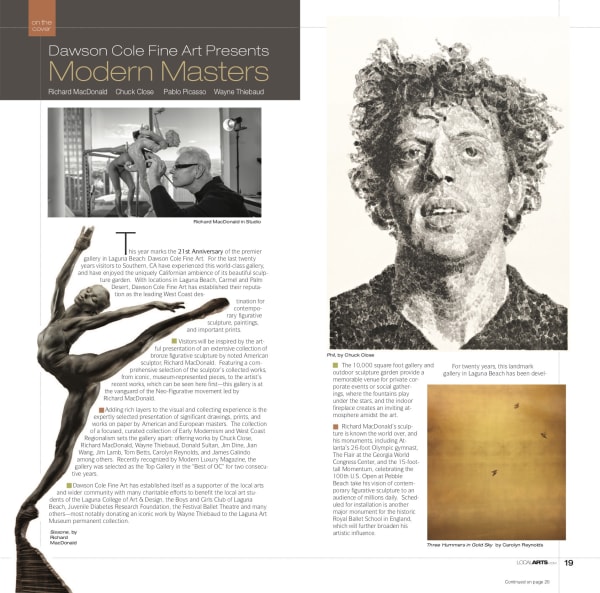Pablo Picasso Spanish, 1881-1973
-
 Pablo PicassoDeux Femmes, 1967Lithograph and Pochoir15.5 x 20.25"
Pablo PicassoDeux Femmes, 1967Lithograph and Pochoir15.5 x 20.25" -
 Pablo Picasso60 Years of Graphic Works: LACMA, 1966Color lithograph29 x 22"
Pablo Picasso60 Years of Graphic Works: LACMA, 1966Color lithograph29 x 22" -
 Pablo PicassoTorero y Señorita (Bullfighter and Young Lady), 1964Lithograph in black and brown14 x 10.25"
Pablo PicassoTorero y Señorita (Bullfighter and Young Lady), 1964Lithograph in black and brown14 x 10.25" -
 Pablo PicassoMusée Municipal D’Art Moderne Céret, 1958Linocut in colors on Arches23.5 x 17.75"
Pablo PicassoMusée Municipal D’Art Moderne Céret, 1958Linocut in colors on Arches23.5 x 17.75" -
 Pablo PicassoLe Concert, 1956Pochoir and collotype15 x 19.5"
Pablo PicassoLe Concert, 1956Pochoir and collotype15 x 19.5" -
 Pablo PicassoTete de Faune Barbu, 1956Collotype and pochoir19.5 x 15"Sold
Pablo PicassoTete de Faune Barbu, 1956Collotype and pochoir19.5 x 15"Sold -
 Pablo PicassoFaune a La Diaule, 1956Collotype and Pochoir19.5 x 15"
Pablo PicassoFaune a La Diaule, 1956Collotype and Pochoir19.5 x 15" -
 Pablo PicassoDonna Nuda, 1955Hand-colored pochoir after Picasso paintings10.43 x 8.46"
Pablo PicassoDonna Nuda, 1955Hand-colored pochoir after Picasso paintings10.43 x 8.46" -
 Pablo PicassoDonna Nella Poltrona Gialla, 1955Hand-colored pochoir after Picasso painting9.84 x 7.28"
Pablo PicassoDonna Nella Poltrona Gialla, 1955Hand-colored pochoir after Picasso painting9.84 x 7.28" -
 Pablo PicassoDonna, Studio per les Demoiselles d'Avignon, 1955Hand-colored pochoir after Picasso painting10.94 x 8.46"
Pablo PicassoDonna, Studio per les Demoiselles d'Avignon, 1955Hand-colored pochoir after Picasso painting10.94 x 8.46" -
 Pablo PicassoStudio per les Demoiselles d'Avignon, 1955Hand-colored pochoir after Picasso painting11.41 - 8.07
Pablo PicassoStudio per les Demoiselles d'Avignon, 1955Hand-colored pochoir after Picasso painting11.41 - 8.07 -
 Pablo PicassoFruttiera e Chitarra su Fondo Grigio, 1955Hand-colored pochoir after Picasso painting8 1/8 x 11 1/8"
Pablo PicassoFruttiera e Chitarra su Fondo Grigio, 1955Hand-colored pochoir after Picasso painting8 1/8 x 11 1/8" -
 Pablo PicassoDiurnes, Femme Assise en Pyjama de Plage, 1962Linocut21.5 x 16.9"Sold
Pablo PicassoDiurnes, Femme Assise en Pyjama de Plage, 1962Linocut21.5 x 16.9"Sold -
 Pablo PicassoLe Ballet, 1954Color lithograph12.25 x 8.5"
Pablo PicassoLe Ballet, 1954Color lithograph12.25 x 8.5" -
 Pablo PicassoTelevision: Combat de Chars a l'Antique, 347 Series, 1968Etching19.75 x 23"
Pablo PicassoTelevision: Combat de Chars a l'Antique, 347 Series, 1968Etching19.75 x 23" -
 Pablo PicassoVieux Peintre et Vieux Modele, 156 Series, 1968Etching8.88 x 12.88"
Pablo PicassoVieux Peintre et Vieux Modele, 156 Series, 1968Etching8.88 x 12.88" -
 Pablo PicassoMinotaure Vaincu (Vanquished Minotaur) from La Suite Vollard, 1933Etching7.5 x 10.5"Sold
Pablo PicassoMinotaure Vaincu (Vanquished Minotaur) from La Suite Vollard, 1933Etching7.5 x 10.5"Sold -
 Pablo PicassoReflexion du Peintre sur la Vie (Reflection of the Painter on Life), 1963Drypoint13.63 x 11.63"
Pablo PicassoReflexion du Peintre sur la Vie (Reflection of the Painter on Life), 1963Drypoint13.63 x 11.63" -
 Pablo PicassoPicasso Histoire de Sabartes et desa Voisine: Les Banderilles, 1957Sugar-lift aquatint with hand-biting8.75 x 10.75"One of 15 recorded proofs
Pablo PicassoPicasso Histoire de Sabartes et desa Voisine: Les Banderilles, 1957Sugar-lift aquatint with hand-biting8.75 x 10.75"One of 15 recorded proofs -
 Pablo PicassoPasse de Cape, 1960Lithograph16.25 x 21"
Pablo PicassoPasse de Cape, 1960Lithograph16.25 x 21" -
 Pablo PicassoExposition Vallauris, 1964Lithograph printed in brown19 x 11"
Pablo PicassoExposition Vallauris, 1964Lithograph printed in brown19 x 11" -
 Pablo PicassoSala Gaspar, Exhibition Poster, 1968Lithograph in color on Arches paper30 x 20.25"
Pablo PicassoSala Gaspar, Exhibition Poster, 1968Lithograph in color on Arches paper30 x 20.25" -
 Pablo PicassoFaune et Centaur, 1956Collotype and Pochoir15 x 19.5"
Pablo PicassoFaune et Centaur, 1956Collotype and Pochoir15 x 19.5"
From the edition of 200 -
 Pablo PicassoPicador au Repos, from Le Carmen des Carmen, 1964Etching35.6 x 26 cm
Pablo PicassoPicador au Repos, from Le Carmen des Carmen, 1964Etching35.6 x 26 cm -
 Pablo PicassoTorero, from "Le Carmen des Carmen", 1964Aquatint14 x 10.25"
Pablo PicassoTorero, from "Le Carmen des Carmen", 1964Aquatint14 x 10.25" -
 Pablo PicassoFemme a la Mantille- Carmen, from "Le Carmen des Carmen", 1964Aquatint14 x 10.25"
Pablo PicassoFemme a la Mantille- Carmen, from "Le Carmen des Carmen", 1964Aquatint14 x 10.25" -
 Pablo PicassoHommage a la Nymphe, 1956Collotype and Pochoir19.5 x 15"From the edition of 200
Pablo PicassoHommage a la Nymphe, 1956Collotype and Pochoir19.5 x 15"From the edition of 200
Arguably the defining artist of the 20th century, Pablo Picasso led the transition out of Realism with inimitable panache. Never before or since has an artist been such a conversation piece; a persona not only in the art world, but in the modern world as a whole. Picasso's sphere of influence reached into a panoply of genres and art forms, from abstraction and Cubism to printmaking and ceramics. As such, his impact was phenomenal, and is still present in art and society; Picasso remains the most exhibited artist in history, and the artists he inspired - from Moore to Miró, Renoir to Warhol - shaped and shifted Modernism.
Arguably the defining artist of the 20th century, Pablo Picasso led the transition out of Realism with inimitable panache. Never before or since has an artist been such a conversation piece; a persona not only in the art world, but in the modern world as a whole. Picasso's sphere of influence reached into a panoply of genres and art forms, from abstraction and Cubism to printmaking and ceramics. As such, his impact was phenomenal, and is still present in art and society. Picasso’s sizable oeuvre grew to include over 20,000 paintings, prints, drawings, sculptures,ceramics, theater sets, and costume designs. He painted his most famous work, Guernica (1937), in response to the Spanish Civil War; the totemic grisaille canvas remains a definitive work of anti-war art. At auction, a number of Picasso’s paintings have sold for more than $100 million. The indefatigable artist has been the subject of exhibitions at the world’s most prestigious institutions, from the Museum of Modern Art and Centre Pompidou to the Stedelijk Museum and Tate Modern. Picasso remains the most exhibited artist in history, and the artists he inspired - from Moore to Miró, Renoir to Warhol - shaped and shifted Modernism.
-

Pablo Picasso: Lines of Genius
Lines of Genius - Opening July 18, 6-8pm 18 - 31 Jul 2025 Laguna BeachPablo Picasso: Lines of Genius showcase a stunning selection of Pablo Picasso's lithographs and etchings, offering a rare glimpse into the mind of one of the most influential artists of...Read more -

Pablo Picasso
Lines of Genius - Opening February 7, 5-7pm 7 - 28 Feb 2025 Palm DesertPablo Picasso: Lines of Genius showcase a stunning selection of Pablo Picasso's lithographs and etchings, offering a rare glimpse into the mind of one of the most influential artists of...Read more -

Blooms and Brushstrokes
A Group Exhibition 11 Jul - 22 Sep 2024 Laguna Beach'Blooms and Brushstrokes' on view from July 11, 2024 through September 22, 2024. 326 Glenneyre Street Laguna Beach, CA (949) 497-4988 RSVP: info@dawsoncolefineart.comRead more -

Splash of Summer
A Group Exhibition 31 Jul - 8 Sep 2023 Laguna Beach, Palm DesertStep into a vibrant world of art that captures the essence of the season at the mesmerizing exhibition, 'Splash of Summer.' This exhilarating showcase is a celebration of all things...Read more -

Red Redefined
The Evocative Power of the Color Red 1 - 28 Feb 2022 Laguna Beach, Palm DesertDawson Cole Fine Art presents an exhibition of works by gallery artists – “Red Redefined.” The group show consists of fourteen works and includes paintings, bronze sculpture, prints, and hand-blown glass by gallery artists.Read more -

LOVE + MODERN BEAUTY
30 Jan - 15 Feb 2021 Laguna BeachDawson Cole Fine Art is pleased to present 'LOVE + MODERN BEAUTY' from January 30- February 15, 2021. There’s something to be said about the holiday’s celebration of love, and...Read more -

A Quest for Identity
1 - 31 Jan 2020 Laguna Beach, Palm DesertIf portraits served the purpose of simply recording physical appearance, then painting would have been made redundant with the earliest developments of photography. Instead, the opposite is true: in the...Read more -

Pablo Picasso: Themes & Variations
6 - 27 Oct 2017 Laguna BeachPicasso devoted an extraordinary amount of time and energy to his pursuit of printmaking, from his earliest etchings created in 1904 at the age of 23, to his final suite...Read more -

An Evening with Picasso
28 - 29 Mar 2014Read more
-

Curated Coastal
Issue 4 March 22, 2022 Read more -

Dawson Cole Fine Art Highlighted: The Best of California 2021
224 Reasons to Love the Golden State: Dawson Cole Fine Art, Laguna Beach May 19, 2021 Read more -

Haute OC Traveler
"An Elegant Evening of Visual Arts with Ariane MacDonald" September 10, 2020https://www.hauteoc.com/an-elegant-evening-of-visual-arts/Read more -

Dawson Cole Fine Arts Presents: Modern Masters
July 24, 2020 Read more -

Dawson Cole Fine Arts: 22nd Anniversary Editorial
March 20, 2017 Read more











































